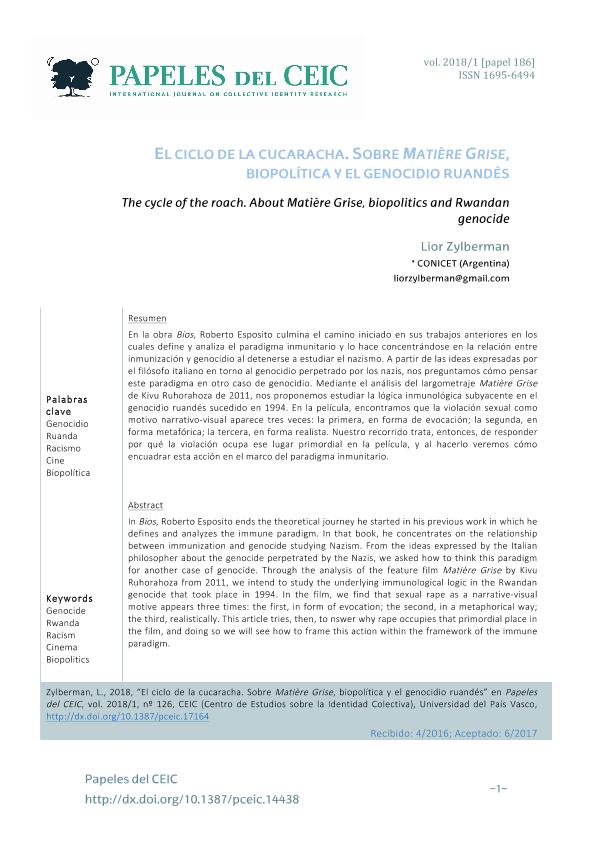Mostrar el registro sencillo del ítem
dc.contributor.author
Zylberman, Lior Alejandro

dc.date.available
2021-07-12T22:23:58Z
dc.date.issued
2018-03-03
dc.identifier.citation
Zylberman, Lior Alejandro; El ciclo de la cucaracha: Sobre Matière Grise, biopolítica y el genocidio ruandés; Universidad del País Vasco; Papeles del CEIC; 2018; 126; 3-3-2018; 1-27
dc.identifier.issn
1695-6494
dc.identifier.uri
http://hdl.handle.net/11336/135906
dc.description.abstract
En la obra Bíos, Roberto Esposito culmina el camino iniciado en sus trabajos anteriores en los cuales define y analiza el paradigma inmunitario y lo hace concentrándose en la relación entre inmunización y genocidio al detenerse a estudiar el nazismo. A partir de las ideas expresadas por el filósofo italiano en torno al genocidio perpetrado por los nazis, nos preguntamos cómo pensar este paradigma en otro caso de genocidio. Mediante el análisis del largometraje Matière Grise de Kivu Ruhorahoza de 2011, nos proponemos estudiar la lógica inmunológica subyacente en el genocidio ruandés sucedido en 1994. En la película, encontramos que la violación sexual como motivo narrativo-visual aparece tres veces: la primera, en forma de evocación; la segunda, en forma metafórica; la tercera, en forma realista. Nuestro recorrido trata, entonces, de responder por qué la violación ocupa ese lugar primordial en la película, y al hacerlo veremos cómo encuadrar esta acción en el marco del paradigma inmunitario.
dc.description.abstract
In Bios, Roberto Esposito ends the theoretical journey he started in his previous works in which he defines and analyzes the immune paradigm. In that book, he concentrates on the relationship between immunization and genocide studying Nazism. From the ideas expressed by the Italian philosopher about the genocide perpetrated by the Nazis, we asked how to think this paradigm for another case of genocide. Through the analysis of the feature film Matière Grise by Kivu Ruhorahoza from 2011, we intend to study the underlying immunological logic in the Rwandan genocide that took place in 1994. In the film, we find that sexual rape as a narrative-visual motive appears three times: the first, in form of evocation; the second, in a metaphorical way; the third, realistically. This article tries, then, to answer why rape occupies that primordial place in the film, and in doing so we will see how to frame this action within the framework of the immune paradigm.
dc.format
application/pdf
dc.language.iso
spa
dc.publisher
Universidad del País Vasco

dc.rights
info:eu-repo/semantics/openAccess
dc.rights.uri
https://creativecommons.org/licenses/by-nc-nd/2.5/ar/
dc.subject
GENOCIDIO
dc.subject
RUANDA
dc.subject
RACISMO
dc.subject
CINE
dc.subject
BIOPOLITICA
dc.subject.classification
Otras Sociología

dc.subject.classification
Sociología

dc.subject.classification
CIENCIAS SOCIALES

dc.subject.classification
Estudios sobre Cine, Radio y Televisión

dc.subject.classification
Arte

dc.subject.classification
HUMANIDADES

dc.title
El ciclo de la cucaracha: Sobre Matière Grise, biopolítica y el genocidio ruandés
dc.title
The cycle of the roach: About Matière Grise, biopolitics and rwandan genocide
dc.type
info:eu-repo/semantics/article
dc.type
info:ar-repo/semantics/artículo
dc.type
info:eu-repo/semantics/publishedVersion
dc.date.updated
2021-07-08T16:43:03Z
dc.journal.volume
2018
dc.journal.number
126
dc.journal.pagination
1-27
dc.journal.pais
España

dc.journal.ciudad
Leioa
dc.description.fil
Fil: Zylberman, Lior Alejandro. Universidad Nacional de Tres de Febrero. Centro de Estudios sobre Genocidio; Argentina. Consejo Nacional de Investigaciones Científicas y Técnicas; Argentina
dc.journal.title
Papeles del CEIC
dc.relation.alternativeid
info:eu-repo/semantics/altIdentifier/doi/http://dx.doi.org/10.1387/pceic.17164
dc.relation.alternativeid
info:eu-repo/semantics/altIdentifier/url/https://ojs.ehu.eus/index.php/papelesCEIC/article/view/17164
Archivos asociados
